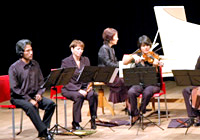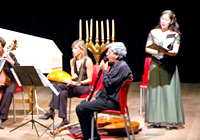Spanish Music History
It comes as no surprise that the evolution of Spanish music is every bit as extensive and diverse as Spain's history. No other European country boasts such a unique melting pot of musical elements, each plucked from the various cultures of Spain's past.
Early Days
Part of what makes Spain so fascinating is the wide range of cultures that have woven their way into its history and culture. During the first eras of Spain's existence, meshing cultures inadvertently impacted each other on every level- and without a doubt contributed significantly to the history of Spanish music. The early Romans brought along ideas and music of neighboring Greece, the rise of the Visigoths saw the flourishing of sacred music and chants stemming from the Church, and under the tolerant Moors, Jewish, Christian, and Moorish music simultaneously blossomed. Regional music was on the rise, but with the reconquista that rise came to a screeching halt as the government declared a prohibition of such music.


Renaissance
The history of Spanish music continued to evolve with the dawning of the Renaissance period. Instrumental music emerged and flourished, most notably with the influence of Arabic music and the development of the Spanish guitar. After the reconquista of the 16th century, the polyphonic singing style, featuring complementing voices, developed probably through contact with Spain's northern neighbors France and Flanders. As mobility throughout the European continent improved, musicians began travelling from country to country - especially to Rome - and picking up ideas and styles along the way. These years of exponential development yanked Spain from anonymity and placed it firmly on the musical map as great classical composers like Francisco Guerrero and Tomás Luis de Victoria surged to the forefront.
17th and 18th Centuries
One of the greatest manifestations of Spain's musical talents appeared during this next period of the history of Spanish music. The zarzuela- a lighter, Spanish form of opera- developed and blossomed, making it the cultural phenomenon that it continues to be today. Contrasting the developments of the previous century, classical music development screeched to a halt and entered into a two-century long decline. The history of Spanish music saw, instead, the surge of popular and folk music throughout the various regions of Spain.
20th Century
After the Spanish Civil War and subsequent fifty-year repressive government, the dictator Francisco Franco, intent on creating a uniform and nationalist country, banned everything pertaining to regional cultures. Regional languages, literature, and music was banned, burned, and berated. As a result, Spain's wide range of folk music that had developed over the past centuries didn't disappear, but its practice was certainly kept hidden from the watchful eyes of Franco's government.
As Spain approached the end of Franco's regime, the rise of pop music and rock 'n' roll marked another important notch in the history of Spanish music. American and British groups were storming the international music scene and not even Franco could prevent Spain from eventually following suit. The earliest Spanish pop essentially imitated French pop, which interestingly enough was already imitating American and British pop. Spanish artists added flamenco passion and rhythms into the mix, giving it a genuine Spanish touch that you can still find in today's pop music. Spain's tourism boom of the 60's and 70's brought in musical styles from all over the world, while the 80's saw the rise of the movida. Following Franco's death young people dabbled in newfound freedom and alternative lifestyles not prevented by the restored democratic government. Spanish rock 'n' roll, punk, and pop music shot to the forefront and has been unstoppable ever since.


